|
FLORIDA GOLF ARCHITECTURE |
FLORIDA
GOLF ARCHITECTURE |
Page 9 From Winter
2012 Florida Golf Magazine ©Copyright 2012, All Rights
Reserved. Subscribe at floridagolfmagazine.com/subscribe
To advertise in Florida Golf Magazine in print and on-line,
phone 863-227-2751 and/or email joestine@floridagolfmagazine.com |
|
“Donald Ross once wrote,
'My work will tell my story,' and that’s how I hope to be
remebered. I find the greatest satisfaction in believing that
I have somehow contributed in making the game I love a more exciting
one to play.” - Pete Dye |
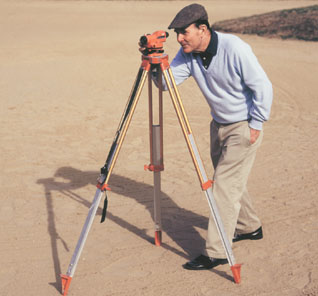
Pete Dye, reading elevation. |
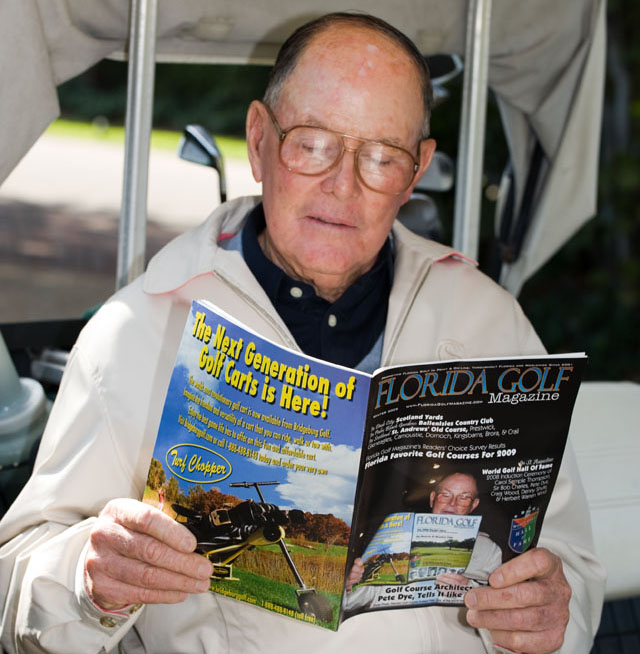
Pete Dye, reading Florida Golf Magazine. |
11
of the top 60 Florida golf courses were designed by P.B. Dye,
Perry Dye, Pete Dye & Alice Dye
Part 1 -
The
Florida Golf Architecture of The First Family of Golf, P.B.,
Perry, Pete & Alice Dye
As
voted in Florida Golf Magazine’s Readers’ Choice Survey
from Jan. 1, 2011 to Dec. 31, 2011, 18.3% of the top 60 Florida
Golf Courses were designed by members of the Dye family, P.B.
Dye, Perry Dye, Pete Dye & Alice Dye. See all 11 courses
listed here. Photos provided by Ken E. May & Rolling Greens
Photography |
|
|
by
Joe Stine, Editor - Florida Golf Magazine |
TPC at Sawgrass - Stadium Course
Ponte Vedra Beach, Pete & Alice Dye, 1981
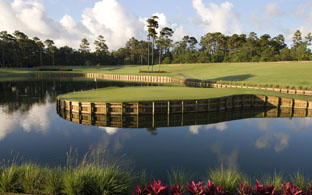 |
At
TPC Sawgrass, it’s the Island Green that gets most of the
attention. But the golf course as a whole is tough. Posting a
respectable score requires a player to combine good shots with
good decisions. The requirement of strategy execution, and patience
are what makes this design, like so many Pete Dye designs, exceptional.
It should be
noted that Alice Dye, co-architect of so many of her husband’s
legendary creations, was the impetus behind his single most notorious
construction. The island green 17th was originally planned as
a simple par-3 with a small adjacent lake. But the fine quality
of the sand next to the green site kept the crew digging, using
the fill on other fairways. |
|
Pete
Dye’s Valley Course at TPC Sawgrass that he designed in
1987 with protegés Jerry Pate & Bobby Weed is an outstanding
test of the game. Though the Valley is considered among Florida’s
top 20 layouts, which is no faint praise in a state with over
1200 golf courses, it still can't help but pale in the shadow
of the iconic Stadium Course.
The Valley Course
at TPC at Sawgrass is an extremely solid layout. It's full of
testing tee shots, beautifully framed fairways, and diverse pin
placements. It's a super quality course, and if it existed as
a stand-alone facility elsewhere in the state, or in Alabama
or Georgia, people would kill to play it. |
TPC at Sawgrass -
Valley Course, Ponte Vedra Bch Pete Dye, Jerry Pate & Bobby
Weed - 1987
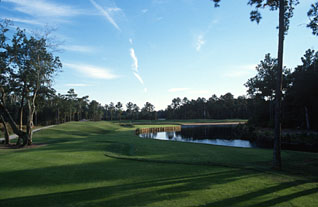 |
|
Amelia Island Plantation
- Oak Marsh
Amelia Island Pete
Dye 1973
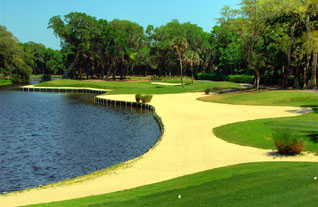 |
Eight
years before the Stadium Course was built, and some 50 miles
north, Dye produced a fine members’ course at Amelia Island
Plantation. Now almost 40 years later, Dye’s original 18
holes at Amelia Island Plantation, now known as Oak Marsh Golf
Course, still exist and offer a staunch but enjoyable challenge
to members and resort guests.
At Oak Marsh,
the waving marsh grasses along the western edge of the property
are beautiful. The closing holes by the marshland are tough,
and the last three holes, with their long , low-country vistas
and scoring difficulty, are both gorgeous and dangerous concurrently.
It is a stellar conclusion to a real sleeper of a golf course. |
|
The
Dye Course was the final piece of the puzzle at the PGA Club,
a classy, well run, and extremely popular 54 hole resort facility
in Port St. Lucie, Florida. The Dye Course is unusual by Florida
standards - almost bereft of water, linksy, open, windswept,
and thought-provoking. It features wide fairways pocked with
heart-sinking pot bunkers and large greens with severe pitch
and roll.
On this pristine
Audubon International Certified Signature Sanctuary Course, mid-fairway
markers provide a sense of direction in an otherwise spare landscape.
The scorecard says Port St. Lucie, but it often feels like Portmarnock,
outside of Dublin, with the snare-drum fairways, scatter-shot
pot bunkers, and out-of-nowhere mounding covered with pampas
grasses. |
PGA Golf Club at the
Reserve - Dye Course
Port St. Lucie Pete
Dye 1970
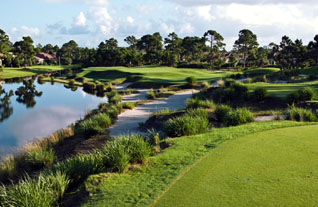 |
|
Walkabout Golf &
Country Club
Mims Perry Dye
& Jan Stephenson 2002
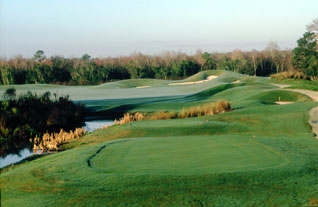 |
Walkabout
Golf and Country Club will satisfy a golfer's palate of any magnitude.
Rich, lush, rolling fairways weave throughout undulating landscape,
surrounded by serene lakes, and Florida’s indigenous flora,
fauna and wildlife. Walkabouts greens are sometimes wildly undulating,
but always quick as lightning, and well guarded by strategically
placed bunkers and collection areas.
The 18-hole,
par 72 course plays 7,115 yards off the Champion tees with a
course rating of 74.3 and a slope of 143. With five sets of tees,
low scores are achievable, especially from the much shorter White
tees where the course plays just 5,587 yards with a rating of
66.9, though still maintaining its par of 72. |
|
Not
even 6,900 yards from the tips, but with a 145 slope, and with
6,400-yard middle markers sloped at a staunch 138. There is a
surfeit of water and encroaching wetlands on virtually every
turn. At West Bay, birdies will be rare, but eagles (of the bald
variety), wild boar, bobcats, herons, snowy egrets, and alligators
are all present, affording plenty of distractions if the golf
becomes frustrating.
Not only is the
golf course an Audubon International Signature Sanctuary, but
taking it one step further the Clinic for the Rehabilitation
Of Wildlife (acronym – C.R.O.W.) has released hundred of
wild animals on site, figuring they’ll thrive in the protected
environment encompassing West Bay Golf Club. |
West Bay Golf Club
Estero Pete
& P.B. Dye 1998
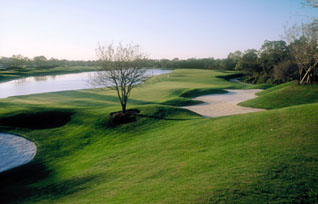 |
|
Dye Preserve Golf
Club
Jupiter Pete
Dye 2002
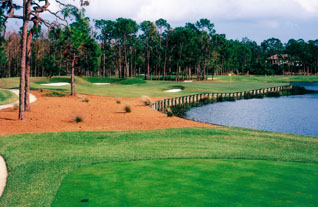 |
This
wonderfully spacious golf course west of Jupiter, represents
a softer, more user-friendly side than one normally associates
with Pete Dye. “We aimed at making a different kind of course
here,”the designer says. “I tried to give the course
a clean, well-defined look. South Florida is dead flat, so the
golfer needs some help to see the shape of every hole from the
tee.”
Joe Webster,
the visionary behind the project chose to honor his longtime
friend and business associate, a man whose skills he has admired
for decades, and named the course “The Dye Preserve.”
Alice, witty provocateur, was comically aghast. “You’ll
never sell any memberships,” she cautioned, half-kidding.
“Don’t you know how many people curse my husband’s
courses?” |
|
P.B.
Dye’s attraction to the original job isn’t hard to
understand. “First of all,” said P.B. “it’s
in the heart of Miami, which is unusual enough. Even in the late
1980s, the property we built on was really valuable, well over
a million dollars an acre.”
Though the architect
had previously been instrumental in helping his father build
some of his most celebrated courses on vast tracts of land, this
was a different situation entirely. “It was a real challenge
to fit nine holes and a driving range in just forty acres,”
says P.B. Dye. “And, it was also great fun to use all the
designing tricks I know that are usually spread across 18 holes,
and fit them into nine.”
“Fisher
Island is a unique location, there’s nothing really like
it. A place like that deserves a golf course that’s equally
special.” |
Fisher Island Resort
Fisher Island P.B.
Dye 1989
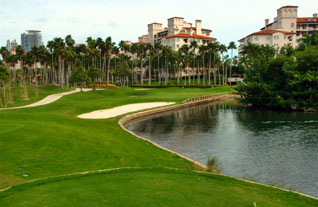 |
|
Old Marsh Country
Club
Palm Beach Gardens Pete
Dye 1988
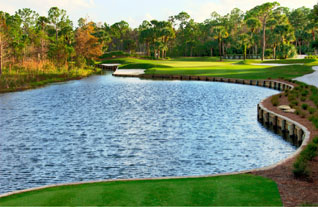 |
Pete
Dye said in regard to Old Marsh Golf Club, “My first glance
at the proposed site made me wonder whether a roaring lion might
appear from deep within the high grass, since the marshland’s
rich vegetation and abundant wildlife reminded me of Africa.”
There are no
lions to be found, but exotic birds – forty species in all
– call Old Marsh home. Anhinga, ibis, sand hill cranes,
blue heron, the shrimp-spearing roseate spoonbill, woodstork,
and dozens of others make Old Marsh not only a friend to the
Audubon Society, but an ornithologist’s reverie. Golfers
will be shaken from their reverie quickly, though, as one forced
carry after another lies in wait. |
|
It
is fair to call Delray Dunes the Dye Equivalent of Donald Ross’s
Pinehurst #2, the magnum opus with which the legendary Scot never
grew tired of tinkering? For though Pete Dye might never reveal
which of his many courses is the closest to his heart, it is
an absolute fact that Delray Dunes is closest to his home in
nearby Gulfstream, Florida and that’s got to count for something.
“Both Alice
and I have a special feeling for Delray Dunes, the first course
I ever designed in Florida,” says Pete. “I’m always
interested in what’s going on over there. I guess that’s
why I’m always stopping by, offering suggestions, and making
improvements. I want the course to be the best it can be, and
it’s a labor of love for me to continue refining it.” |
Delray Dunes Golf
& Country Club
Boynton Pete
Dye 1969
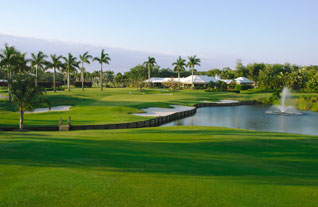 |
|
Harbour Ridge Yacht
& Country Club - River Ridge
Palm City Pete
& P.B. Dye 1989
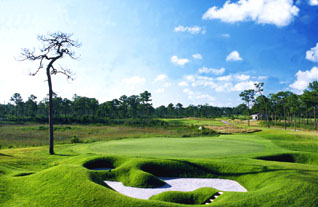 |
The
River Ridge Course at Harbour Ridge Yacht & Country Club
isn’t even 6,700 yards from the tips, but the slope rating
is a sky-high 148. The blue markers tip the scales at a seemingly
anemic 6,200-and-change, but are sloped at an ultra-formidable
142. The white tees are pegged at a distance normally associated
with senior tees – less than 5,600 yards, yet with a 129
slope. And bear in mind it’s a regulation par-72 course.
The river views
are limited to the par four 420 yard 3rd Hole. While the panoramic
river view is fleeting, environmentally protected wetlands encroaching
on the fairways are an enduring fact on the River Ridge Course,
so bring extra golf balls. |
Part
1 - The
Florida Golf Architecture of The First Family of Golf, P.B.,
Perry, Pete & Alice Dye
Page 9 From Winter
2012 Florida Golf Magazine ©Copyright 2012, All Rights
Reserved. Subscribe at floridagolfmagazine.com/subscribe
To advertise in Florida Golf Magazine in print and on-line,
phone 863-227-2751 and/or email joestine@floridagolfmagazine.com |
|